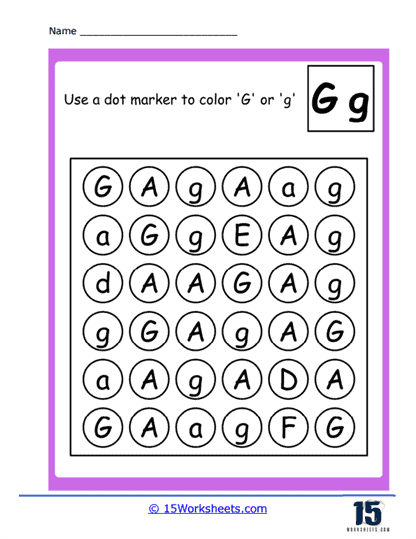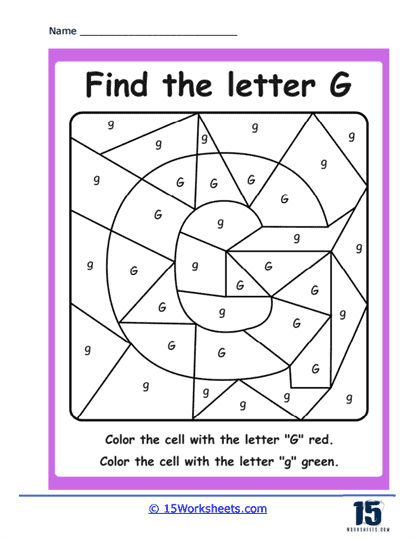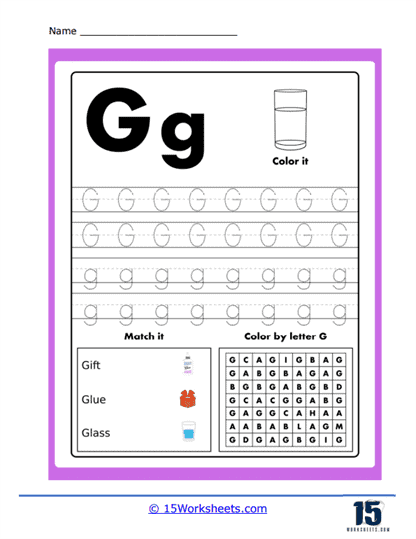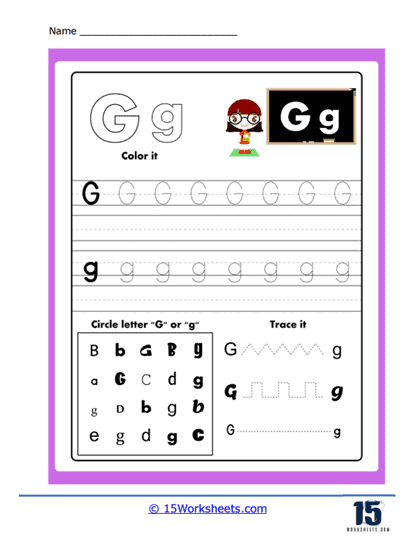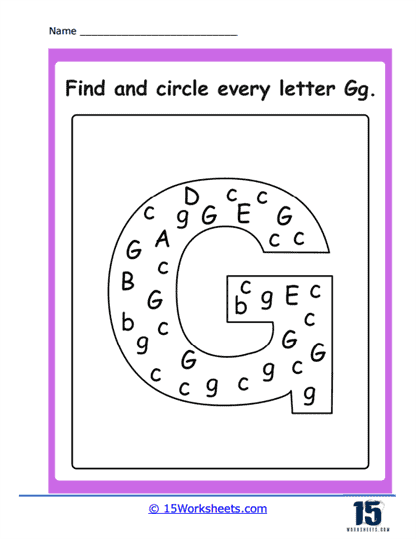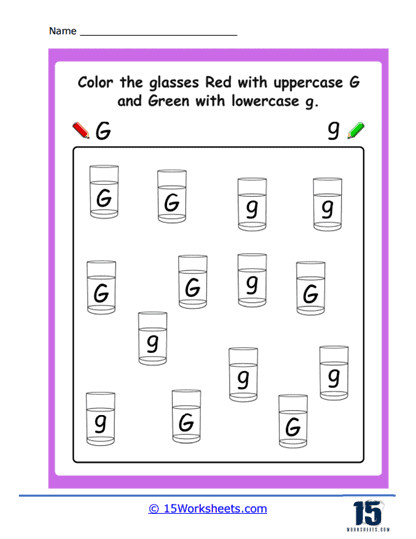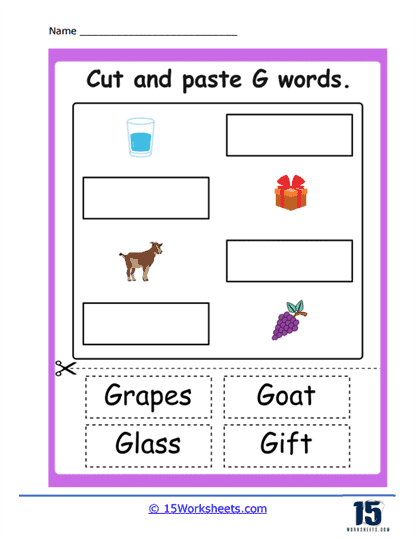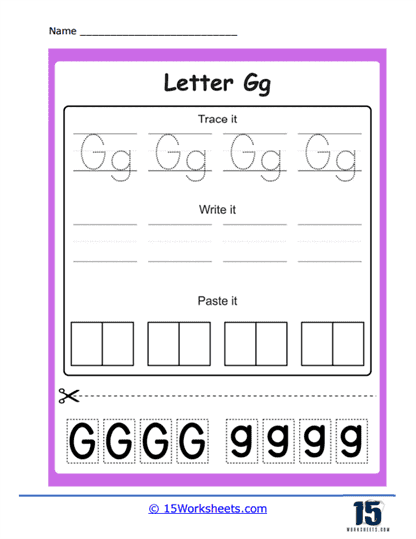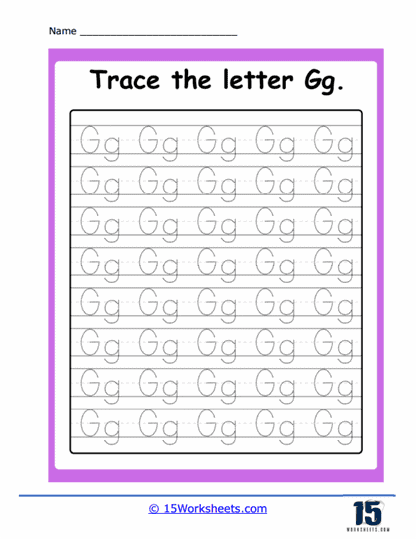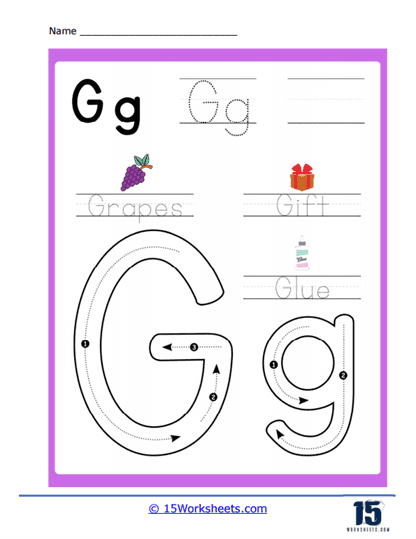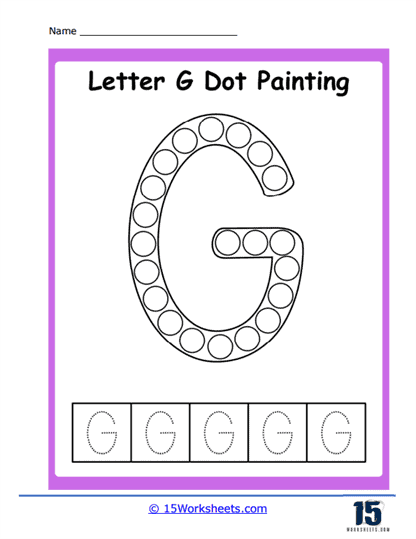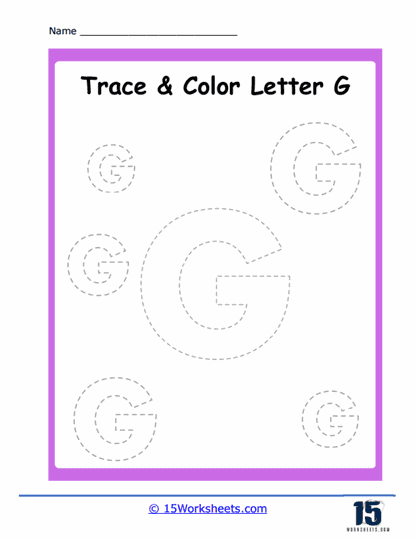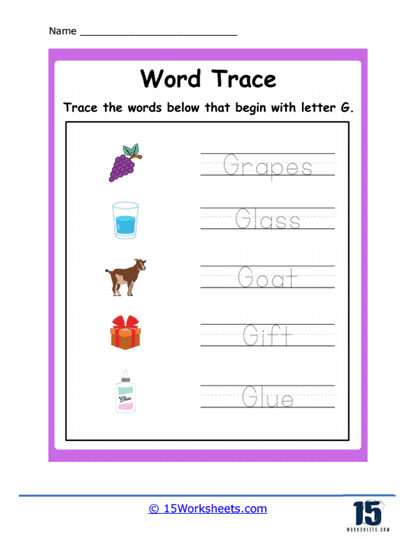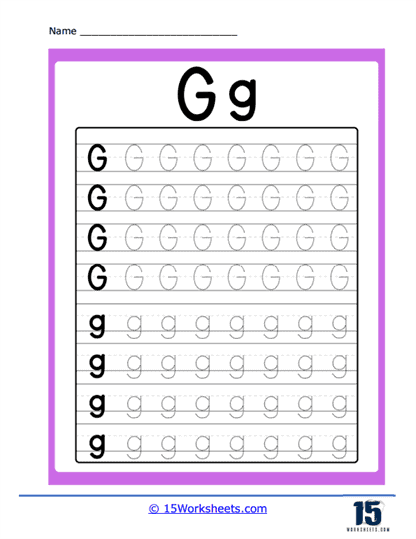Letter G Worksheets
About These 15 Worksheets
Our Letter G worksheets were meticulously crafted to support your journey in mastering one of the most important building blocks of language: the letter ‘G’. As one of the 26 essential components of the English alphabet, the letter ‘G’ plays a significant role in reading, writing, and communication. These worksheets are more than just simple exercises-they are interactive tools designed to make learning dynamic and enjoyable. Think of them as engaging puzzles that teachers or parents can use to help enhance your understanding of this letter. By transforming the learning process into a series of fun challenges, these worksheets aim to strengthen your language skills while keeping you motivated. You’ll be amazed at how many different methods there are to deepen your familiarity with the letter ‘G’-all while having fun along the way.
You may wonder why we focus on learning one letter at a time. The answer is simple: learning can sometimes feel overwhelming, especially when you’re faced with the entire alphabet. By concentrating on one letter at a time, like the letter ‘G’, we can break down the learning process into manageable, bite-sized pieces. This approach helps to ease the learning curve, making it simpler and more effective to absorb and retain new information. While these worksheets are perfect for beginners, they also serve as excellent tools for more advanced learners, allowing you to refine your skills in the same way practicing a sport makes you better at it. Repetition and focus are key to mastery, and by honing in on the letter ‘G’, you’ll find your overall language abilities improving step by step.
Within this collection of worksheets, you’ll encounter a variety of activities designed to sharpen different aspects of your knowledge about the letter ‘G’. One of the most common exercises involves tracing the letter ‘G’ in both its uppercase and lowercase forms. This practice not only helps you become more familiar with how the letter is written but also improves your handwriting. Tracing the letter repeatedly creates muscle memory, making it easier to write clearly and confidently in the future. And don’t forget-‘G’ has two distinct forms: the uppercase ‘G’ and the lowercase ‘g’. Mastering both versions will enhance your understanding of when and how to use them in different contexts.
Another enjoyable activity found in these worksheets involves scanning blocks of text to locate all instances of the letter ‘G’. This type of exercise is both a fun challenge and a practical way to sharpen your recognition skills. It teaches you to quickly identify the letter ‘G’ when reading, which in turn helps improve your reading fluency and accuracy. The more you practice, the faster you’ll become at spotting the letter ‘G’, which is a critical skill for reading proficiency.
But learning isn’t limited to tracing and recognition-our worksheets also incorporate coloring activities to further reinforce your understanding of the letter ‘G’. For example, you might be presented with images of various objects, and your task is to color only those that begin with the letter ‘G’, like a picture of grapes or a guitar. This activity not only makes learning enjoyable but also builds your vocabulary by introducing new words associated with the letter ‘G’. It’s an engaging way to connect letters with real-world objects and expand your language knowledge through playful interaction.
In addition to tracing, recognition, and coloring, some worksheets feature fill-in-the-blank exercises that focus on completing words with the letter ‘G’. For instance, you might see an image of a goat with the word partially spelled out as “_oat”, and it’s your job to fill in the missing letter ‘G’. These activities strengthen your ability to associate words and sounds with their corresponding letters. They encourage critical thinking, as you must first identify the picture and then determine which letter completes the word. This type of exercise builds a stronger connection between visual cues and written language, helping you to become a more proficient reader and writer.
In essence, these Letter G worksheets are a comprehensive collection of interactive puzzles and games, each focusing on a single letter of the alphabet-the letter ‘G’. They’re designed not only to teach you how to write and recognize this letter but also to deepen your understanding of the different sounds it makes in various words. By practicing with these worksheets, you’re not just learning a letter; you’re developing essential language skills in an engaging and enjoyable way. And remember, the more you practice, the more confident and capable you’ll become in your language journey.
Origins of the Letter G – From Ancient Egypt to Greece
The story of “G” begins with the Phoenician alphabet, an ancient writing system used by the Phoenicians around 1050 BCE. The Phoenicians, a seafaring people from the region of modern-day Lebanon, created a script that significantly influenced the development of later alphabets, including Hebrew, Greek, and Latin. The Phoenician alphabet used symbols to represent sounds, and it originally contained a character called “gimel,” which stood for a sound similar to the modern hard “G” (as in “go”). “Gimel” itself is thought to have been derived from an even earlier Egyptian hieroglyph representing a camel, giving the letter a pictographic origin related to the animal.
The Phoenician “gimel” was adopted by the Greeks, but in the Greek alphabet, it became the letter “gamma” (Γ, γ). Gamma, like gimel, was used to represent the hard “G” sound. However, as the Greek language evolved, the letter “gamma” also came to represent a soft sound, like a voiced velar fricative. The Greeks adapted the form of the letter from the Phoenician, but instead of maintaining the pictorial representation of a camel, the shape became more abstract and angular, closer to what we recognize as the modern “G.”
The Introduction of G in the Latin Alphabet
The history of the letter “G” takes an important turn when we move to the Etruscan and Latin alphabets. The Latin alphabet, which forms the basis of modern European writing systems, was influenced by the Etruscans, who themselves borrowed from the Greek alphabet. In the early Roman alphabet, there was no distinct letter “G.” Instead, the letter “C” was used for both the “K” and “G” sounds, which created ambiguity in pronunciation.
It was the Roman grammarian Spurius Carvilius Ruga who, in the 3rd century BCE, is credited with the invention of the letter “G.” He modified the letter “C” by adding a small hook or tail to distinguish it from the hard “K” sound, thus creating a new letter for the “G” sound. This innovation resolved the confusion between “C” and “G” in Latin writing and speech. Over time, the letter “G” was placed in the seventh position of the alphabet, replacing the Greek letter “zeta” (Z), which was deemed unnecessary for Latin. The letter “Z” was later reintroduced into the Latin alphabet, but “G” maintained its place as the seventh letter.
The Evolution of G Through Languages
As the Latin alphabet spread across Europe through the Roman Empire, the letter “G” traveled with it, eventually finding its way into the writing systems of many languages. In English, the letter “G” has a dual nature – it can represent a hard sound, as in “go” or “give,” and a soft sound, as in “giant” or “giraffe.” This duality arose during the Middle Ages, when French influence on the English language led to the softening of some “G” sounds. In Romance languages like French, Italian, and Spanish, the soft “G” typically occurs before the vowels “e” and “i,” while the hard “G” remains before other vowels. In English, this rule has generally been adopted as well, although there are exceptions due to the language’s eclectic nature.
In some languages, such as German and Dutch, the “G” sound remains more guttural, resembling the original Greek or Phoenician pronunciation. The versatility of “G” across languages is a testament to its adaptability and the way languages evolve through contact and historical shifts.
Fun Facts About the Letter G
The Camel Connection – The letter “G” has roots in the Phoenician “gimel,” which was linked to the word for “camel.” Some linguists believe that the original shape of the letter was meant to resemble a camel’s neck or a figure walking with a stick, highlighting how ancient letters often had pictographic origins. Though its shape changed dramatically over time, the idea that the letter once symbolized a camel is a quirky piece of linguistic history.
G as a Musical Note – The letter “G” plays a key role in music theory, where it represents the fifth note in the diatonic scale. In particular, the “G-clef,” also known as the treble clef, is one of the most widely used symbols in musical notation. This clef spirals around the line representing the note “G” on the staff, helping musicians identify pitch.
The Silent G – English is notorious for its silent letters, and “G” is no exception. In words like “gnome,” “gnat,” and “sign,” the “G” is silent, often due to the influence of Old English or other Germanic languages. Interestingly, in older forms of English, the “G” in these words may have been pronounced, but over time, the sound disappeared while the letter remained.
G in Technology – In modern times, “G” has taken on new meanings, particularly in the realm of technology. Most notably, the “G” in “5G” refers to the fifth generation of mobile network technology, indicating a major advancement in the speed and capacity of wireless communication. This use of “G” shows how letters can gain new life and significance as technology evolves.
Superstitions and Symbolism – In some cultures, the letter “G” has taken on symbolic meanings. For example, in Freemasonry, the letter “G” is often associated with both “God” and “geometry,” representing the intersection of faith and science. This symbolic use reflects how letters can carry deep meaning beyond their phonetic function.
Alphabetical Position – In the context of word games like Scrabble, “G” is worth 2 points, making it a moderately valuable letter. Its placement in the alphabet (seventh) also makes it significant for various mnemonics and codes, as the number 7 has often been considered lucky or mystical in different cultures.

